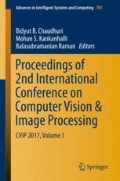Abstract
In this paper, we propose a novel V-LESS technique for generating the event summaries from monocular videos. We employed Linear Discriminant Analysis (LDA) as a machine learning approach. First, we analyze the features of the frames, after breaking the video into the frames. Then these frames are used as input to the model which classifies the frames into active frames and inactive frames using LDA. The clusters are formed with the remaining active frames. Finally, the events are obtained using the key-frames with the assumption that a key-frame is either the centroid or the nearest frame to the centroid of an event. The users can easily opt the number of key-frames without incurring the additional computational overhead. Experimental results on two benchmark datasets show that our model outperforms the state-of-the-art models on Precision and F-measure. It also successfully abates the video content while holding the interesting information as events. The computational complexity indicates that the V-LESS model meets the requirements for the real-time applications.
Access this chapter
Tax calculation will be finalised at checkout
Purchases are for personal use only
References
Singh N., et al., “A Novel Position Prior Using Fusion of Rule of Thirds and Image Center for Salient Object Detection,” MTAP (2016), pp. 1–18.
Vermaak J., et al., “Rapid summarization and browsing of video sequences,” BMVC, (2002), pp. 1–10.
Krishan K., et al., “Event BAGGING: A novel event summarization approach in multi-view surveillance videos,” IEEE IESC’17.
Truong B.T., Venkatesh S., “Video abstraction: a systematic review and classification,” ACM Trans. Multimed. Comp. Comm. App., 3, 1, (2007), 37 pages.
Chowdhury A. S., et al., “Video Storyboard Design using Delaunay Graphs,” Int. Conf. on Pattern Recog., (2012), pp. 3108–3111.
Mundur P., Rao Y., Yesha Y., “Keyframe-based video summarization using Delaunay clustering,” Int. J. Digit. Libr., 6, 2, (2006), pp. 219–232.
Kumar K., et al., “Equal Partition based Clustering approach for Event Summarization in Videos,” SITIS, 2016, pp. 119–126.
Chang H.S., et al., “Efficient video indexing scheme for content-based retrieval,” IEEE TCSVT, 9, 8, (1999), pp. 1269–1279.
Gong Y., Liu X., “Video summarization using singular value decomposition,” IEEE CVPR, 2, (2000), pp. 174–180.
K. Kumar, et al., “Eratosthenes sieve based key-frame extraction technique for event summarization in videos,” MTAP (2017), pp. 1–22.
Zhuang Y., et al., “Adaptive key frame extraction using unsupervised clustering,” IEEE ICIP, 1, (1998), pp. 866–870.
K. Kumar, et al., “SOMES: An efficient SOM technique for Event Summarization in multi-view surveillance videos,” Springer ICACNI’17.
Sahouria, E., et al., “Content analysis of video using principal components.” IEEE TCSVT, 9, 8, (1999), pp. 1290–1298.
Altman, E. I., et al. “Corporate distress diagnosis: Comparisons using linear discriminant analysis and neural networks (the Italian experience).”, Journal of banking & finance, 18, 3, (1994), pp. 505–529.
Furini M., et al., “Stimo: still and moving video storyboard for the web scenario,” Multimed. Tools Appl. 46, 1, (2010), pp. 47–69.
Avila S., et al., “Vsumm: a mechanism designed to produce static video summaries and a novel evaluation method,” Pattern Recognit. Lett., 32, 1, (2011), pp. 56–68.
OVP, “Video Open Project Storyboard,” https://open-video.org/results.php?size= extralarge, Retrieved December, 2016.
Cong Y., et al., “Towards scalable summarization of consumer videos via sparse dictionary selection,” IEEE TMM, 14, 1, (2012), pp. 66–75.
Guan G., et al., “Keypoint based keyframe selection,” IEEE Trans. Circuits Syst. Video Tech., 23, 4, (2013), pp. 729–734.
Mei S., et al., “Video summarization via minimum sparse reconstruction,” Pattern Recog., 48, 2, (2015), pp. 522–533.
Author information
Authors and Affiliations
Corresponding author
Editor information
Editors and Affiliations
Rights and permissions
Copyright information
© 2018 Springer Nature Singapore Pte Ltd.
About this paper
Cite this paper
Kumar, K., Shrimankar, D.D., Singh, N. (2018). V-LESS: A Video from Linear Event Summaries. In: Chaudhuri, B., Kankanhalli, M., Raman, B. (eds) Proceedings of 2nd International Conference on Computer Vision & Image Processing . Advances in Intelligent Systems and Computing, vol 703. Springer, Singapore. https://doi.org/10.1007/978-981-10-7895-8_30
Download citation
DOI: https://doi.org/10.1007/978-981-10-7895-8_30
Published:
Publisher Name: Springer, Singapore
Print ISBN: 978-981-10-7894-1
Online ISBN: 978-981-10-7895-8
eBook Packages: EngineeringEngineering (R0)

